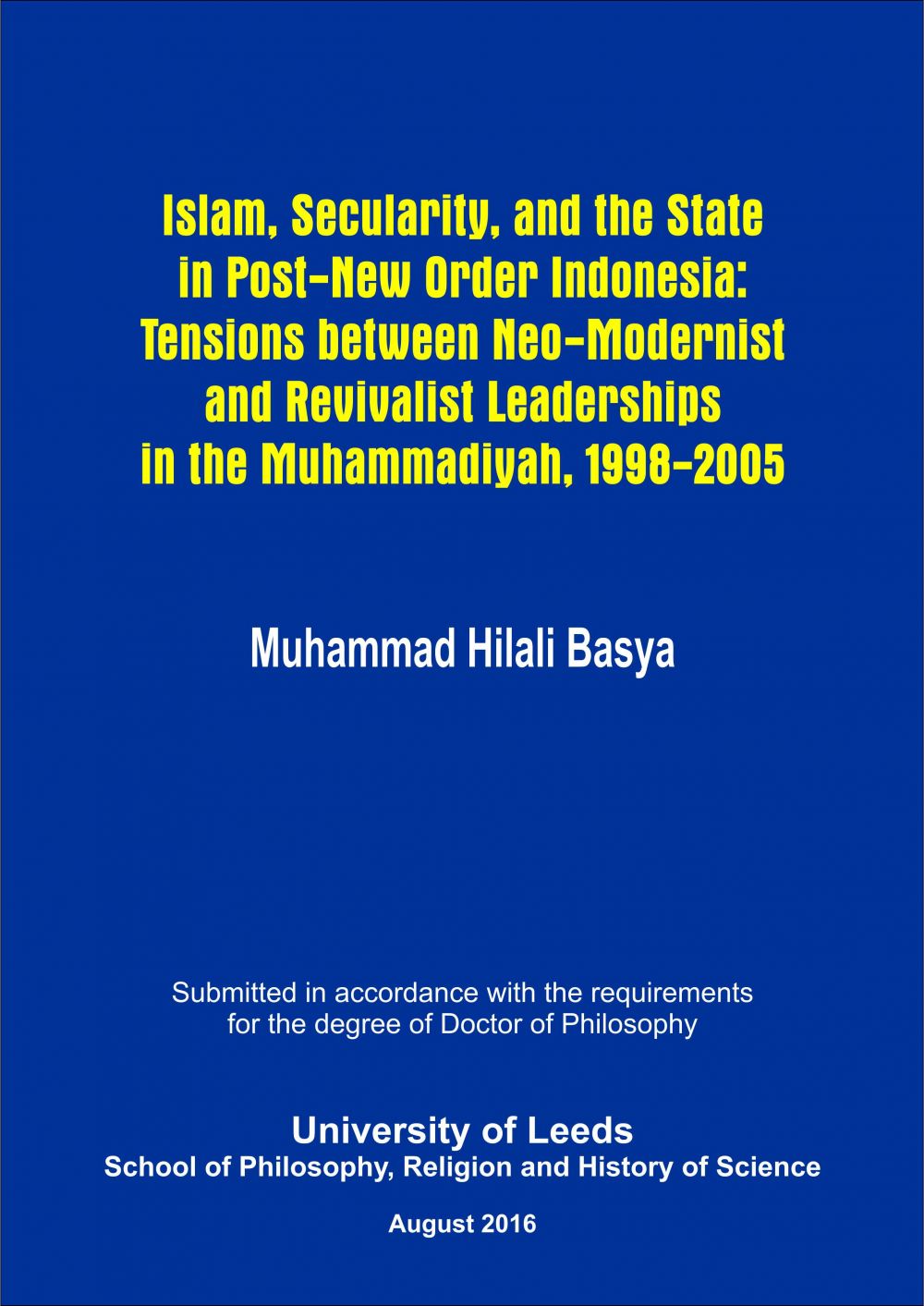Tensions between Neo-Modernist and Revivalist Leaderships in the Muhammadiyah 1998-2005
Dibaca: 1281
Penulis : Muhammad Hilali Basya
Abstract
This thesis explores how Muslims negotiate Islam, secularity and the modern state (Chapter 1) through examining the views of Muslim leaders in Indonesia during the colonial and postcolonial periods (Chapter 2), and, in particular, through a case study of the leadership of the Muhammadiyah – one of the two largest Islamic organisations in the country (Chapter 3). In the main body of my thesis I focus on the post-New Order period (1998–2005) when Indonesia underwent a transition from state authoritarianism to experiments with democracy. During this time of new political freedom, various Islamic movements pushed for the Islamization of the state, revisiting earlier debates with supporters of secularism following Indonesia’ independence. Notably, this changing context also exposed tensions within the Muhammadiyah between more marginal revivalists and more dominant neomodernist groupings with rather different conceptions of Islam’s relationship to the state and secularity. To investigate this further I undertook fieldwork in Indonesia between 2012 and 2013, adopting qualitative research methods to consult the organisation’s archives, other publicly available material and interview both revivalist and neo-modernist leaders at different levels of the Muhammadiyah: 11 central board members, 8 ‘ulama and 16 activists (Chapter 4). Analysing their different responses to three key post-New Order debates about the relationship between Islam, secularity and the modern state – the position of Islam in the constitution (Chapter 5); the position of shari‘a in the law (Chapter 6); and regarding non-Muslim leadership (Chapter 7) – my main argument is that in contrast to the revivalists who support a shari‘a-based state, Muhammadiyah neo-modernist opinion tends to endorse the idea of the ‘neutrality’ of the state while still supporting the public recognition (and even prioritisation) of Islamic identity. My research shows that having higher education and/or wider engagement in organizations concerned with democracy, human rights, and religious pluralism is a significant influence on the extent to which Muhammadiyah leaders develop such neomodernist ideas. Nevertheless, I also conclude that the wider post-New Order political context of conflict between revivalists and secularists, typically saw neomodernists, and particularly those in the Muhammadiyah central board, seek points of convergence with revivalists that would maintain the movement’s overall unity.
Table of Contents
Introduction - 1
Negotiating religion and politics in the Islamic world - 4
Islam and the state in late colonial and post-colonial Indonesia: from contestation to negotiation -8
The Muhammadiyah and the state in post-New Order Indonesia -14
Cultural and social capital of Muhammadiyah leaders -21
Literature review -24
The structure of the thesis -28
Chapter 1 Muslims and the Nation-State in Modernity
1.1 Introduction - 33
1.2 Modernity and the nation-state -36
1.3 Early modernization in Islamic world -42
1.4 A typology of Muslims’ responses to modernity -45
1.4.1 Secular modernists or secularists -46
1.4.2 Islamic modernists and neo-modernists -47
1.4.3 Islamic revivalists -50
1.5 The nation-state and umma -53
1.6 The nation-state and shari‘a -59
1.7 Conclusion -63
Chapter 2 The Relationship between Islamic Movements and the State in Post-Colonial Indonesia
2.1 Introduction -66
2.2 Islamization in Indonesia: the emergence of santri and abangan in the colonial period -69
2.3 Indonesian Muslims and modernity -78
2.4 The quests for an Islamic and a secular modern state -82
2.5 New Order attitudes toward Islamic movements -91
2.6 The rise of Islamic neo-modernism and the shift in the state’s attitude to Islamic groups -96
2.7 Conclusion -104
Chapter 3 The Muhammadiyah’s Changes in Attitude towards the NationState in Indonesia
3.1 Introduction -106
3.2 Ahmad Dahlan -109
3.3 The Muhammadiyah in the Dahlan Period -113
3.4 The Shift in the Muhammadiyah’s attitudes towards the colonial state after Dahlan -120
3.5 The Muhammadiyyah and the rise of Islamic revivalism -125
3.6 The Quest for an Islamic Nation State and the emergence of Islamic neomodernism - 130
3.7 Conclusion -136
Chapter 4 Research Methodology
4.1 Introduction -140
4.2 The researcher’s standpoint -143
4.3 The research approach -147
4.4 The research method -148
4.4.1 Documents -149
4.4.2 Interviewing -152
4.4.3 Participant Observation -161
4.5 Data analysis -16
4 4.6 Ethical Issues -165
4.7 Conclusion -167
Chapter 5 Conceptualizing the Relationship of Islam and the State: The Debate on the Amendment of Article 29 of UUD 1945
5.1 Introduction -170
5.2 Democratic transition and the amendment of the constitution -174
5.3 Muhammadiyah’s central board members’ rejection of the constitutionalization of shari‘a -180
5.4 The negotiations between neo-modernist and revivalist orientations in the Muhammadiyah -187
5.5 Critical views from the revivalist wing of the central board -192
5.6 The ‘ulama: Islamizing the state versus negotiating Islam -198
5.6.1 The first type of Muhamadiyah ‘ulama: Islamizing the state -199
5.6.2 The second type of Muhammadiyah ‘ulama: modernizing Islam -203
5.7 The activists: Nationalizing Islam -208
5.7.1 Profile of Muhammadiyah activists -208
5.7.2 Muhammadiyah activists’ views on the amendment - 210
5.8 Conclusion - 215
Chapter 6 The Secularization of Shari‘a: Recognizing the Role of Parliament in Producing Law
6.1 Introduction -217
6.2 Regional autonomy and shari‘a-based district regulations - 220
6.3 The Muhammadiyah’s position: leaders’ positions on the regulations - 226
6.4 Neo-modernist and revivalist views on shari‘a and the intersections between their views -233
6.5 ‘Ulama: secularizing shari‘a vs establishing a shari‘a-based state -236
6.5.1 The First type of ‘ulama: shari‘a-based state -236
6.5.2 The second type of ‘ulama: secularizing shari‘a -239
6.6 The activists: secularizing shari‘a -243
6.7 Conclusion -248
Chapter 7 Understanding Views concerning non-Muslims Leadership in the Majority Muslim State
7.1 Introduction -251
7.2 External conflict and internal cohesion -254
7.3 The central board: the seruan and the different perceptions of neomodernists and revivalists -258
7.4 The ‘ulama’s attitudes concerning non-Muslim leadership -265
7.4.1 The first type of ‘ulama: the distrust of non-Muslim leadership -265
7.4.2 The second type of ‘ulama: revivalist and neo-modernist orientations -267
7.5 Activists’ trust in non-Muslims and the influence of social capital -272
7.6 Conclusion - 278
Conclusion- 280
Bibliography - 293
or HERE
Tags: MuhammadHilaliBasya , TensionsbetweenNeo-ModernistandRevivalistLeaderships








